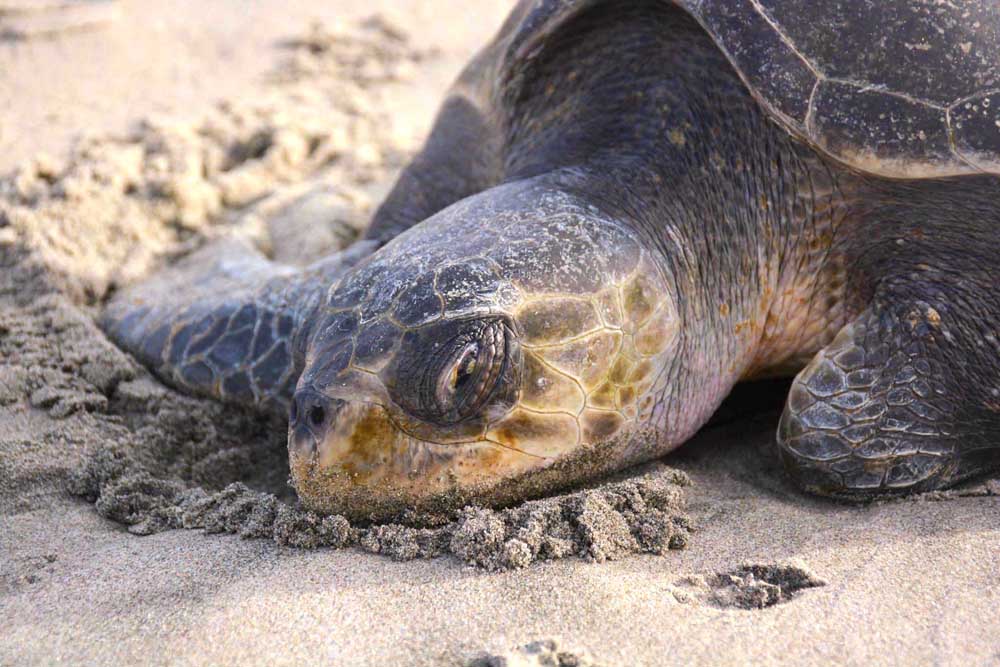Aquarium News: The olive ridley
Published 7:45 pm Monday, November 2, 2020

- Hypothermic sea turtles can appear to be dead. Their heart rate my slow down to one beat per minute.
Here is a possible (and quite startling!) scenario that may unfold during a wintery beachcombing expedition on the Oregon Coast: While perusing the beach for treasures, you might suddenly come across something large that you don’t quite recognize.
A rock, perhaps? Then it hits you; this “large rock” is actually a 50-pound sea turtle!
Unbeknownst to most, during the winter, cold-shocked sea turtles can become stranded on our beaches. Reports of stranded turtles can begin as early as mid-October and continue through January.
Essentially, sea turtles forage for food in an offshore, warm water current. Weather conditions (such as a long, constant string of south-southwesterly winds) can drive the warm water current (and therefore the turtles) further north and closer to shore than normal.
When the weather conditions suddenly change, the warm waters quickly dissipate and the turtles find themselves trapped in the colder waters of the natural currents running along the Oregon and Washington state coasts.
When this happens, their bodies slow down and they become hypothermic. Those that can make it to shore haul out to get out of the cold water, but the winter conditions on the beach are rarely more hospitable.
When found on the beach, it can be difficult to determine if a sea turtle is dead or alive.
A turtle suffering from extreme hypothermia can be unresponsive to touch and have a heartbeat so slow and weak that it is difficult to detect. Most sea turtles found on Oregon and Washington shores do not survive, even if found and recovered quickly.
Those that do live are taken to one of two licensed rehab facilities on the Northwest coast; the Oregon Coast Aquarium or the Seattle Aquarium. When stabilized (which, if successful, can take up to a few weeks), the turtle is transferred to a center in California, where it will be released back into the wild.
Though the Oregon Coast may see as many as five different species of sea turtle, the most commonly found is the olive ridley (Lepidochelys olivacea). This is partly due to the fact that, globally, they are the most abundant species of sea turtle (with an estimated population of 800,000 nesting females). Even with such seemingly “robust” numbers, these turtles are considered endangered and face many threats from the modern world. The expansion of the shrimp trawling fishery in the eastern Indian Ocean has had a major impact on the olive ridley population, contributing to up to 10,000 deaths each year.
Thankfully, in 2004 the Odisha government introduced an annual fishing ban from November to May (the time of year when the turtles are nesting) that has reduced their incidental mortality by half, and surveys found that nesting surged to record numbers in 2011.
Another major threat to the olive ridley population is their own biology. They are one of only two species of sea turtle to engage in synchronized mass-nesting (a behavior called arribadas).
This means that almost simultaneously, thousands of female turtles will pull themselves out of the water and high up onto the beach, in the darkness of night to lay their eggs. With competition for space high, females often dig up another female’s nest, unintentionally destroying the newly laid eggs in order to deposit her own eggs.
Olive ridley sea turtles return to the same beach they were hatched on to lay their eggs. The largest rookery (nesting site) is located on Gahirmatha Beach in India with a nesting population between 100,000 to 500,000 individuals each year. Other nesting sites can be found in Costa Rica, Mexico, and Nicaragua.
After the crowded nesting season is over, the ridleys return to their quiet, solitary life where they roam the oceans of the world, living in multiple different habitats and geographical localities.





